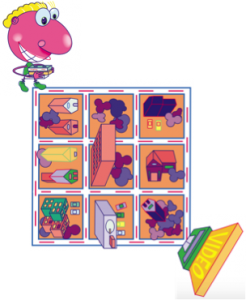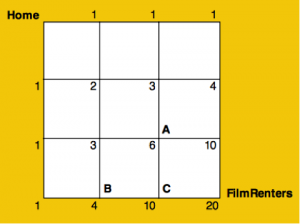Problem:
1. How can you go straight to the FilmRenters from home when
there are buildings in the way?
2. Extension: How long is the shortest route from home to FilmRenters?


Children and their parents worked on the above stated problem at the Family Science and Mathematics Day at UBC.
We taped several copies of our statement of the problem at our station. As parents and their children walked past our station, some of them stopped to enquire about our problem. This problem was presented to our problem-solvers in several different ways. If a child were interested in the problem, we would state it as “how many different ways are there to go from this point to that point (pointing at the start and end points).” If both the parent(s) and their child were interested, we would pose the problem as, “how many different ways are there to go to your school from your home.” If the parent(s) were interested in the problem, we would pose it as “how many different ways are there to go to the grocery store from home with the shortest distance.”
Children started thinking about and engaging with the problem right away. Several students pointed out that their first solution was to go diagonally straight from the start to the finish. We entertained their first solution, just so that they would engage with the problem a little bit more. Then we slowly added constraints by asking, “what if there are buildings that you cannot go through” or “what if your parents/guardians are driving you.” Their parents were encouraging their children by often times saying, “oh yeah, that makes sense.” These constraints seemed to have caught some of them off-guard. For them, I guess that going through, over, or under seemed completely plausible. Even though the printout of the problem appeared to mimic 3-dimensional objects, I suspect that some of them might not have noticed this detail. One student even ran away to the physics lab when we introduced the constraints. With these constraints, I think that some of the children understood that this problem was related to day-to-day events of going from one place to another. Some of them were like, “oh, I get it. It’s like walking on the side of a road.” Once they understood the problem, some of them were reluctant to move on to other activities at the fair. They were glued to this problem.
This problem turned out to be surprisingly difficult for most of the problem-solvers. Once they understood the problem, they randomly started guessing, checking, and tracing different paths with their fingers. We even noticed one student moving just his head when tracing the path. Since they were randomly searching for and finding solutions, we asked several of them to simplify the original problem and start finding solutions with 1 x 1 block and then to move on to 2 x 2 blocks. This suggestion seemed to have worked a little bit. Many of them were able to find all the solutions to 1 x 1 and 2 x 2 blocks, however, without finding a pattern. This meant that when they moved onto the 3 x 3 blocks again, they were randomly looking for solutions. At this point, we gave another hint. The hint was to consider either the upper or lower half of the blocks along the diagonal. After spending more than half an hour at our station, this hint led to one child solving the problem completely. Her mother was separately working on the problem and didn’t seem to be surprised when her daughter was able to solve the problem. As the mother-daughter duo were about to leave our station, we asked them think about the case of 4 x 4 blocks and how it may be related to the Pascal’s triangle.
I think that we unintentionally made the process of solving our problem difficult. First, we did not provide any paper or pencil so that problem-solvers could somehow keep track of their solutions. Second, the printout of the statement of the problem was not of good quality. Third, the visual presentation of the problem itself was not appealing (no manipulatives). Last, some of the students appeared tired and were reluctantly directed to our station by their parents.
The presentation of this problem could have been improved. Instead of the A4 color printout, we could have actually created visually appealing graphics that would have looked like real roads and the building could have been pattern blocks (or some manipulatives) stacked together. Instead of tracing the paths with their fingers, we could have provided miniaturized cars, bikes, or something else so that problem-solvers would be able to visualize what it was that they were doing. Even better, use of 2-D and 3-D software to recreate this problem would have been much more appealing to many students, who appeared to be tech-savvy. By using technology, we could have eliminated the mundane (but sometimes useful) process of keeping track of previously found solutions.
This problem could be extended to the secondary level with minor changes to the constraints of the problem. For instance, we could ask students to create interesting variations to the original problem, come up with strategies to generalize the number of different paths for n x n blocks (or irregular shapes), or relate to prior knowledge from other areas of mathematics (polynomials, Pascal’s triangle, combinatorics, etc.).
If I had an opportunity to meet with some of the problem-solvers from this fair, it would have to be the mother and her daughter, who were intent on solving the problem. Often times, we incorrectly assume that teachers are the primary sources of fostering mathematical knowledge, curiosity, and problem-solving abilities. At this fair, I witnessed that the mother and her daughter were supporting and encouraging each other to solve the problem. From time to time, the mother would look over her shoulder and ask her daughter a question or two. Like, “wow, how did you get that many” or “can you show me how you did that.” To which the child would explain her reasoning behind her gradually increasing number of solutions. Their enthusiasm to solve the problem seemed to feed off each other’s ideas and interests. It appeared to me like it was more of an ongoing partnership or teamwork to solving problems than anything else. Over the course of working on the problem, the mother did say that she likes mathematics and that she likes to solve puzzles with her daughter in the evenings. It was encouraging to see how parental involvement at home and support at the fair led them to concentrate for an extended period of time to successfully solve this problem. So I can kind of understand why her mother was not too surprised by her daughter’s problem-solving abilities.
